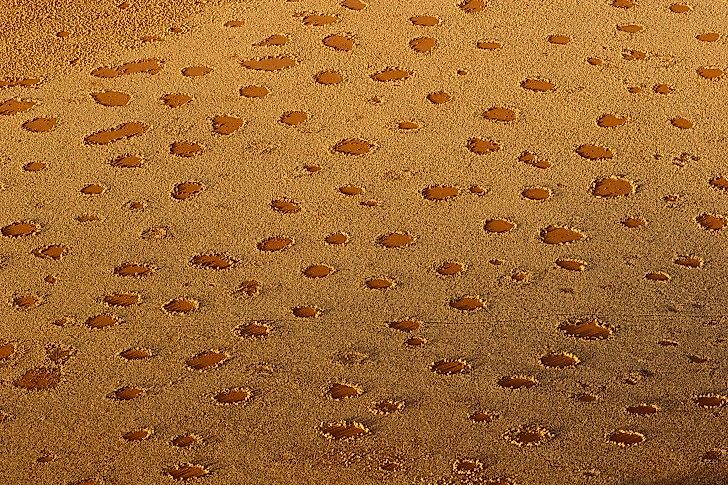What Are Fairy Circles, And Why Do They Occur?

5. What Are Fairy Circles?
Fairy circles are circular, barren patches of land, with a diameter varying between 2 to 15 meters, encircled by a stimulated growth of grass. The exact occurrence of these fairy circles is not yet known. The circles usually appear in arid landscapes with monospecific grassy vegetation, forming surprisingly regular patterns in the grassy terrains. Once formed, these circles do not disappear quickly, and have a life-cycle of around 30 to 60 years, regularly shrinking and expanding. Invasion by surrounding grasses is the primary reason for the disappearance of these circles.
4. Where Are They Found?
The appearance of fairy circles in Africa has been known for a long time. They have been spotted over large areas of remote, inhospitable landscapes, especially in a band of land 160 kilometers inland stretching from Angola for a distance of 2,400 kilometers to the northwestern Cape province of South Africa. The fairy circles are especially common in Namibia. However, in 2014, a new discovery was made, when similar patches across the circular barren land were spotted in Pilbara in Western Australia, 15 kilometers away from the mining town of Newman in the same province. These fairy circles, when viewed aerially, appear like barren red circles pockmarking the grassy carpet over large stretches of arid land.
3. What Causes This Phenomenon?
Both scientific and supernatural causes have been assigned to the formation of these fairy circles. Locals in Africa consider the circular patterns to be the works of spirits and deities. However, scientists have striven to find proper explanations for these phenomena based on scientific knowledge. Some of the early scientific hypotheses claimed that the fairy circles were the work of grazing ants, toxic plants, or underground leakages of radioactive gas bubbling up. Among these and several other explanations put forward to explain the mysterious appearance of the fairy circles, two main hypotheses have found the greatest support from the scientific world.
One of the hypotheses has been proposed by Norbert Juergens of the University of Hamburg in Germany. He contends that the fairy circles are crated by sand termites inhabiting the arid, grassland landscapes. These termites gnaw away the roots of grasses in a circular patch of land, allowing the rainwater to collect underneath the soil instead of being lost by absorption to the roots of the grasses. This water stores are then utilized by the termites for their numerous needs. The presence of competitive termite colonies in the same areas could account for the regular spacing of the fairy circles at safe distances form their opportunistic neighbors. However, a section of natural scientists appear not to be convinced, as they find it hard to believe that termites would be able to produce the strictly ordered patterns seen among fairy circles. Another hypothesis, and the more popular one, is the "self-organization hypothesis", which claims that plants growing in the arid landscapes where fairy circles occur are engaged in a kind of tug-of-war, wherein they vigorously compete with each other for water and nutrients. This battle for water triggers a self-organization of the landscape, wherein rings of deep rooted grasses surround a patch of barren land which serves as a vegetation-deprived water reservoir from where the plant roots' can collect their much needed water.
2. Scientific Implications
If any of these hypotheses are proven to be true, it will provide us with a much deeper understanding of certain living organisms’ adaptations to survive, especially drought-tolerant ones. If true, the fairy circles could be regarded as engineering wonders of the insect or plant world (depending on the hypothesis deemed as correct) where, much like humans, these species manage to modify their surrounding habitats to make provisions for their own long term survival.
1. Unanswered Questions and Ongoing Research
Even though scientists have managed to provide some explanations in regards to the formation of the fairy rings, there is as of yet no experimental proof as to how these natural wonders are created. Even though computerized models of fairy circles have been created for studying the effects of changing natural factors on the size, number, and shape of these fairy circles, in-field study is the only way to prove the proposed scientific hypotheses. If the scientists are able to prove that, by artificially manipulating soil and water conditions and termite populations, they are able to shrink or grow the fairy circles, it might be accepted as sufficient enough of data to be proving one of the above mentioned hypotheses. However, as of yet only time will tell whether modern science will be able to solve this natural puzzle or not.











